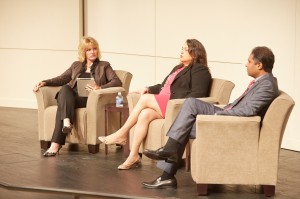
Jill Dyché, internationally recognized speaker, author and business consultant, spends her days talking to businesses about big data – how they’re using it, challenges, successes, strategies, plans and more.
What she’s hearing again and again from IT leaders is that they have to innovate with big data, move quickly and stay relevant. At the same time, they have to maintain their existing infrastructures — which often involve decades-old systems. They have to move fast, but they also have to keep the lights on.
At the SAS Financial Services Summit last week, Dyché moderated a panel discussion featuring two renowned IT leaders and early adopters of big data: Lynne Labrador, Director of Global Operations Technology for Citigroup, and Venkat Achanta, Global Head of Analytics and Big Data for AIG. They discussed the challenges associated with evolving analytics programs and how they support big data.
“Citi is more than 200 years old, and our legacy systems get in our way,” says Labrador. “We have a big data vision, executive sponsor and have hired a chief data officer. But our challenge is: How do you take all that data, bring in data to make decisions quickly, and work with clunky systems?”
“AIG is big and old – and like 200 mini-companies working separately,” says Achanta. “We don’t have a total data view, but we’re working on it. Data and analytics is our differentiator, and we have made a lot of investments in that space.”
One solution? Centralized analytics
Insurance giant AIG is committed to centralizing its analytics ecosystem and using analytics competitively because it makes good business sense. Consider, Achanta says, the nature of insurance claims data. “Most of our data is unstructured. Being able to do a Google search of notes, visualize the data and democratize it, cluster claims based on keywords, map clusters of where injuries occur – that’s where the value is for AIG.”
AIG is at the start of its big data journey, says Achanta, but it’s making progress quickly. “Every project has to fit into our strategic goals and the road map we’ve set.”
“At Citi, we’ve been looking at our analytics ecosystem as well,” says Labrador. “If we can streamline and reduce the number of applications, it’s going to make us much more agile. We have a centralized business intelligence group, but we also have silos at the country level. That’s what we’re trying to change.”
To that end, Citi has mandated that all technology spending must come out of the Global Operations Technology division instead of the regions. “We want to buy once and deploy globally,” says Labrador.
What’s next?
At Citi, Labrador and her team are listening to business needs and trying to solve problems, for example, two-way SMS. “If you’ve ever gotten a decline on your card and a text to call your bank, that’s not helpful,” says Labrador. “In those cases, customer service needs to resolve the fraud alert and avoid the revenue impact involved in a declined card. How do we solve it? It all happens at point of sale. Text back ‘1’ if it’s you, and we’ve saved point of sale and resolved the alert.”
At AIG, the goal is to further drive the analytics culture. “We’re requiring actuaries to know SAS and build models for predictive analytics. We’re creating centers of excellence and having skilled analysts train others,” says Achanta. “Our shared services infrastructure helps show the benefits of analytics and how analytics could be leveraged across the entire organization to help all functions. We mean business when we talk analytics.”
Final recommendations
No matter how old your systems are, no matter how big or small your company is, you can follow AIG and Citi’s lead, incorporating new big data initiatives into existing infrastructures and processes. After reviewing customers’ big data roadmaps and noting what worked, Dyché’s team built this nine-step big data road map that includes all the components of success:
- Learn about big data. For example, how is it different than your relational data, and how are big data systems evolving?
- Identify and prioritize the opportunities. This is where most projects fail, so make sure you understand the business problem you’re solving.
- Get executive commitment.
- Build the team (which will likely evolve over time).
- Implement the initial project.
- Share the results. What have you done and how is it different from what’s been done before? Make sure what you’re producing adds value.
- Evaluate the project. Note what worked and what didn’t.
- Refine processes and measure value.
- Start and implement the next project.
“Each of these steps has its own associated sub-processes, explains Dyché. Define the project, implement it, lift your head, see what worked, formalize what worked and do it again,” she says. “That way, you’ll evolve toward a delivery framework that’s right for your company.”
